Holmes Institute HA3042: Taxation Law Individual Assignment T2 2019
VerifiedAdded on 2022/11/14
|6
|2144
|55
Homework Assignment
AI Summary
This document presents a comprehensive solution to a taxation law assignment, addressing two main questions. The first question analyzes various transactions involving capital assets, including a house, a car, a small cleaning business, furniture, and paintings, to determine the applicability of Capital Gains Tax (CGT) and relevant exemptions. The analysis considers the residency status of the individual, the nature of the assets (personal use, collectables, business), and specific provisions of the Income Tax Assessment Act 1997, such as the pre-1985 asset exemption, the small business CGT exemption, and the exclusions for personal use assets and collectables. The second question focuses on the capitalization and depreciation of an industrial CNC machine purchased by a manufacturing company, detailing the costs to be included in the asset's value and the date from which depreciation should commence. The solution references relevant sections of the Income Tax Assessment Act and provides a detailed breakdown of the costs incurred, concluding with the total cost for capitalization and the starting date for capital allowance computation. References to academic sources are included to support the analysis.
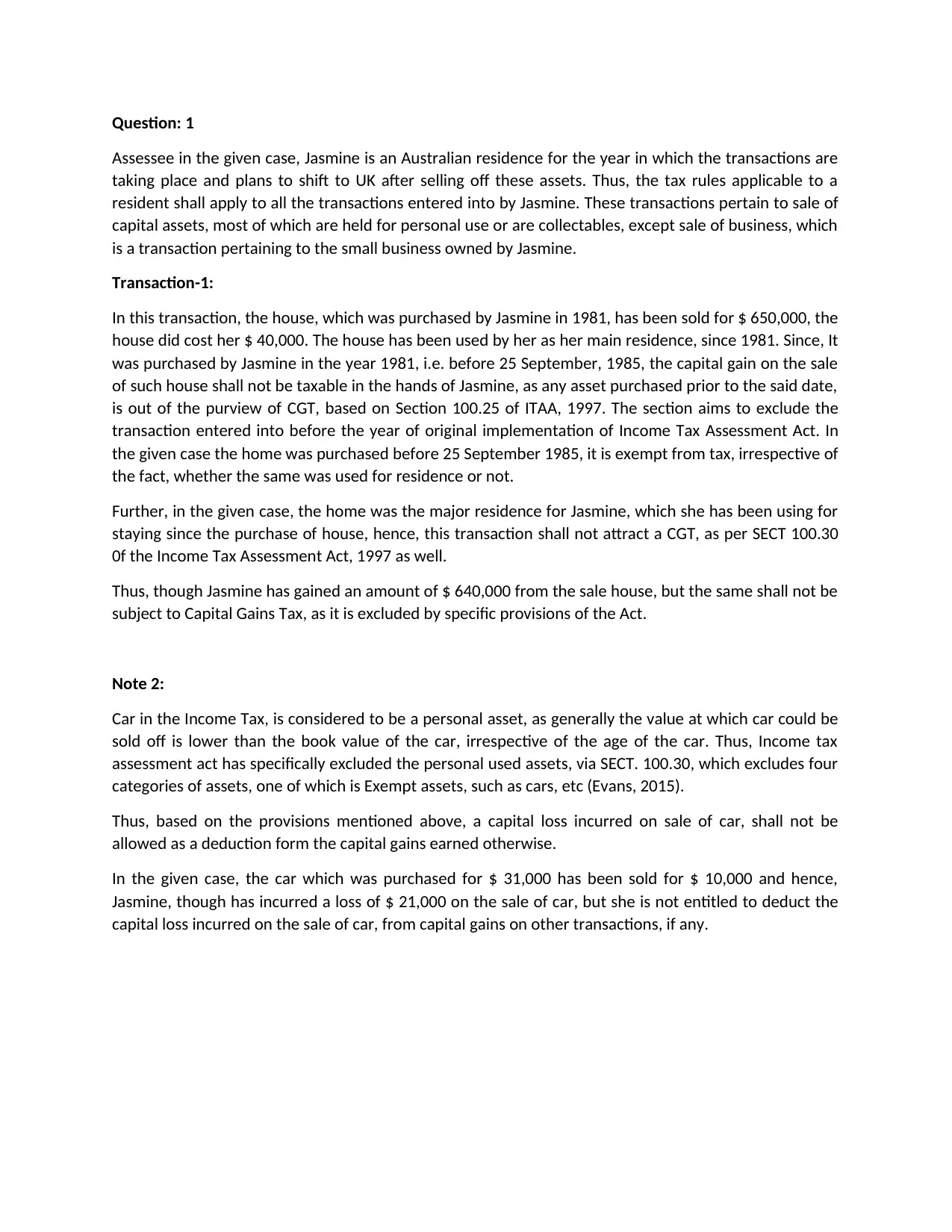
Question: 1
Assessee in the given case, Jasmine is an Australian residence for the year in which the transactions are
taking place and plans to shift to UK after selling off these assets. Thus, the tax rules applicable to a
resident shall apply to all the transactions entered into by Jasmine. These transactions pertain to sale of
capital assets, most of which are held for personal use or are collectables, except sale of business, which
is a transaction pertaining to the small business owned by Jasmine.
Transaction-1:
In this transaction, the house, which was purchased by Jasmine in 1981, has been sold for $ 650,000, the
house did cost her $ 40,000. The house has been used by her as her main residence, since 1981. Since, It
was purchased by Jasmine in the year 1981, i.e. before 25 September, 1985, the capital gain on the sale
of such house shall not be taxable in the hands of Jasmine, as any asset purchased prior to the said date,
is out of the purview of CGT, based on Section 100.25 of ITAA, 1997. The section aims to exclude the
transaction entered into before the year of original implementation of Income Tax Assessment Act. In
the given case the home was purchased before 25 September 1985, it is exempt from tax, irrespective of
the fact, whether the same was used for residence or not.
Further, in the given case, the home was the major residence for Jasmine, which she has been using for
staying since the purchase of house, hence, this transaction shall not attract a CGT, as per SECT 100.30
0f the Income Tax Assessment Act, 1997 as well.
Thus, though Jasmine has gained an amount of $ 640,000 from the sale house, but the same shall not be
subject to Capital Gains Tax, as it is excluded by specific provisions of the Act.
Note 2:
Car in the Income Tax, is considered to be a personal asset, as generally the value at which car could be
sold off is lower than the book value of the car, irrespective of the age of the car. Thus, Income tax
assessment act has specifically excluded the personal used assets, via SECT. 100.30, which excludes four
categories of assets, one of which is Exempt assets, such as cars, etc (Evans, 2015).
Thus, based on the provisions mentioned above, a capital loss incurred on sale of car, shall not be
allowed as a deduction form the capital gains earned otherwise.
In the given case, the car which was purchased for $ 31,000 has been sold for $ 10,000 and hence,
Jasmine, though has incurred a loss of $ 21,000 on the sale of car, but she is not entitled to deduct the
capital loss incurred on the sale of car, from capital gains on other transactions, if any.
Assessee in the given case, Jasmine is an Australian residence for the year in which the transactions are
taking place and plans to shift to UK after selling off these assets. Thus, the tax rules applicable to a
resident shall apply to all the transactions entered into by Jasmine. These transactions pertain to sale of
capital assets, most of which are held for personal use or are collectables, except sale of business, which
is a transaction pertaining to the small business owned by Jasmine.
Transaction-1:
In this transaction, the house, which was purchased by Jasmine in 1981, has been sold for $ 650,000, the
house did cost her $ 40,000. The house has been used by her as her main residence, since 1981. Since, It
was purchased by Jasmine in the year 1981, i.e. before 25 September, 1985, the capital gain on the sale
of such house shall not be taxable in the hands of Jasmine, as any asset purchased prior to the said date,
is out of the purview of CGT, based on Section 100.25 of ITAA, 1997. The section aims to exclude the
transaction entered into before the year of original implementation of Income Tax Assessment Act. In
the given case the home was purchased before 25 September 1985, it is exempt from tax, irrespective of
the fact, whether the same was used for residence or not.
Further, in the given case, the home was the major residence for Jasmine, which she has been using for
staying since the purchase of house, hence, this transaction shall not attract a CGT, as per SECT 100.30
0f the Income Tax Assessment Act, 1997 as well.
Thus, though Jasmine has gained an amount of $ 640,000 from the sale house, but the same shall not be
subject to Capital Gains Tax, as it is excluded by specific provisions of the Act.
Note 2:
Car in the Income Tax, is considered to be a personal asset, as generally the value at which car could be
sold off is lower than the book value of the car, irrespective of the age of the car. Thus, Income tax
assessment act has specifically excluded the personal used assets, via SECT. 100.30, which excludes four
categories of assets, one of which is Exempt assets, such as cars, etc (Evans, 2015).
Thus, based on the provisions mentioned above, a capital loss incurred on sale of car, shall not be
allowed as a deduction form the capital gains earned otherwise.
In the given case, the car which was purchased for $ 31,000 has been sold for $ 10,000 and hence,
Jasmine, though has incurred a loss of $ 21,000 on the sale of car, but she is not entitled to deduct the
capital loss incurred on the sale of car, from capital gains on other transactions, if any.
Paraphrase This Document
Need a fresh take? Get an instant paraphrase of this document with our AI Paraphraser
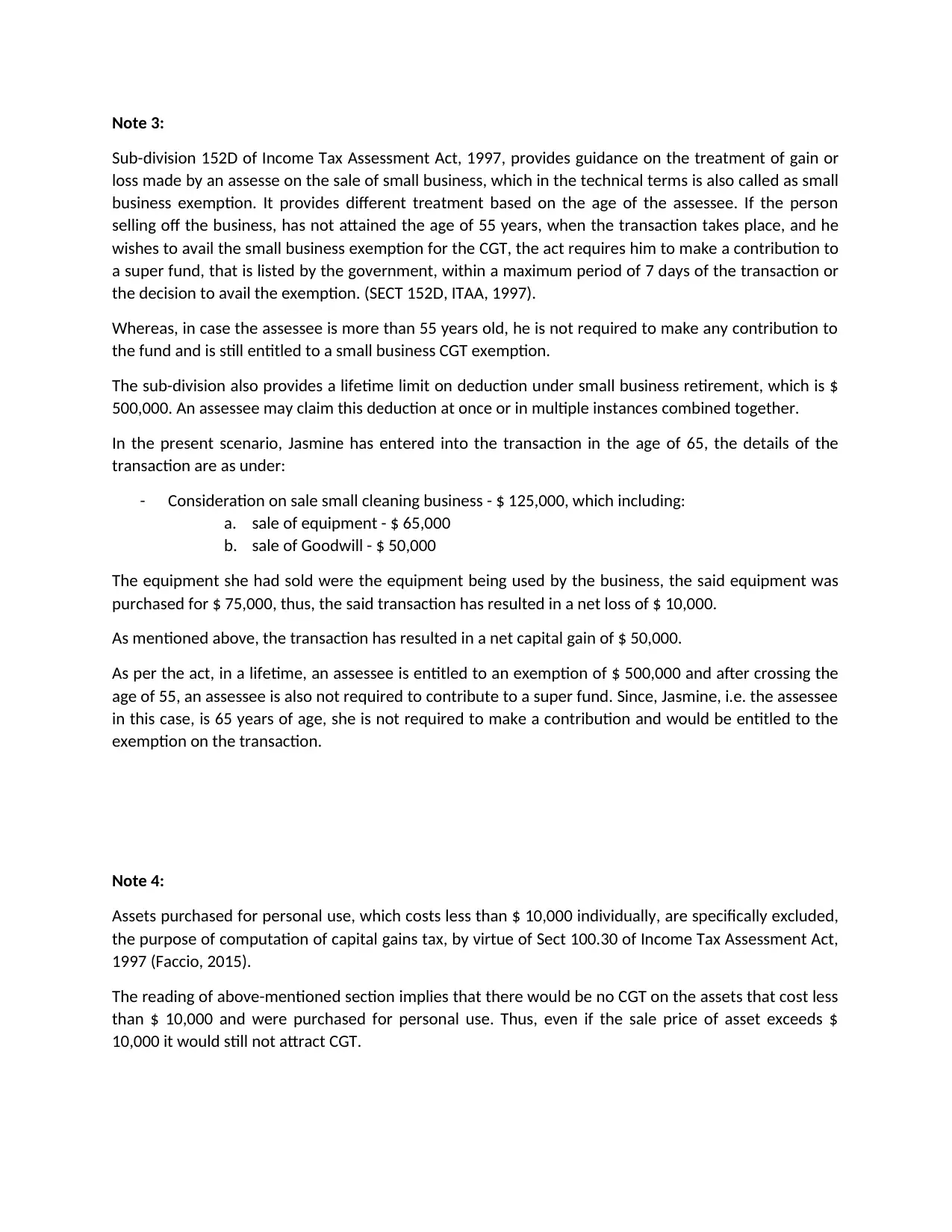
Note 3:
Sub-division 152D of Income Tax Assessment Act, 1997, provides guidance on the treatment of gain or
loss made by an assesse on the sale of small business, which in the technical terms is also called as small
business exemption. It provides different treatment based on the age of the assessee. If the person
selling off the business, has not attained the age of 55 years, when the transaction takes place, and he
wishes to avail the small business exemption for the CGT, the act requires him to make a contribution to
a super fund, that is listed by the government, within a maximum period of 7 days of the transaction or
the decision to avail the exemption. (SECT 152D, ITAA, 1997).
Whereas, in case the assessee is more than 55 years old, he is not required to make any contribution to
the fund and is still entitled to a small business CGT exemption.
The sub-division also provides a lifetime limit on deduction under small business retirement, which is $
500,000. An assessee may claim this deduction at once or in multiple instances combined together.
In the present scenario, Jasmine has entered into the transaction in the age of 65, the details of the
transaction are as under:
- Consideration on sale small cleaning business - $ 125,000, which including:
a. sale of equipment - $ 65,000
b. sale of Goodwill - $ 50,000
The equipment she had sold were the equipment being used by the business, the said equipment was
purchased for $ 75,000, thus, the said transaction has resulted in a net loss of $ 10,000.
As mentioned above, the transaction has resulted in a net capital gain of $ 50,000.
As per the act, in a lifetime, an assessee is entitled to an exemption of $ 500,000 and after crossing the
age of 55, an assessee is also not required to contribute to a super fund. Since, Jasmine, i.e. the assessee
in this case, is 65 years of age, she is not required to make a contribution and would be entitled to the
exemption on the transaction.
Note 4:
Assets purchased for personal use, which costs less than $ 10,000 individually, are specifically excluded,
the purpose of computation of capital gains tax, by virtue of Sect 100.30 of Income Tax Assessment Act,
1997 (Faccio, 2015).
The reading of above-mentioned section implies that there would be no CGT on the assets that cost less
than $ 10,000 and were purchased for personal use. Thus, even if the sale price of asset exceeds $
10,000 it would still not attract CGT.
Sub-division 152D of Income Tax Assessment Act, 1997, provides guidance on the treatment of gain or
loss made by an assesse on the sale of small business, which in the technical terms is also called as small
business exemption. It provides different treatment based on the age of the assessee. If the person
selling off the business, has not attained the age of 55 years, when the transaction takes place, and he
wishes to avail the small business exemption for the CGT, the act requires him to make a contribution to
a super fund, that is listed by the government, within a maximum period of 7 days of the transaction or
the decision to avail the exemption. (SECT 152D, ITAA, 1997).
Whereas, in case the assessee is more than 55 years old, he is not required to make any contribution to
the fund and is still entitled to a small business CGT exemption.
The sub-division also provides a lifetime limit on deduction under small business retirement, which is $
500,000. An assessee may claim this deduction at once or in multiple instances combined together.
In the present scenario, Jasmine has entered into the transaction in the age of 65, the details of the
transaction are as under:
- Consideration on sale small cleaning business - $ 125,000, which including:
a. sale of equipment - $ 65,000
b. sale of Goodwill - $ 50,000
The equipment she had sold were the equipment being used by the business, the said equipment was
purchased for $ 75,000, thus, the said transaction has resulted in a net loss of $ 10,000.
As mentioned above, the transaction has resulted in a net capital gain of $ 50,000.
As per the act, in a lifetime, an assessee is entitled to an exemption of $ 500,000 and after crossing the
age of 55, an assessee is also not required to contribute to a super fund. Since, Jasmine, i.e. the assessee
in this case, is 65 years of age, she is not required to make a contribution and would be entitled to the
exemption on the transaction.
Note 4:
Assets purchased for personal use, which costs less than $ 10,000 individually, are specifically excluded,
the purpose of computation of capital gains tax, by virtue of Sect 100.30 of Income Tax Assessment Act,
1997 (Faccio, 2015).
The reading of above-mentioned section implies that there would be no CGT on the assets that cost less
than $ 10,000 and were purchased for personal use. Thus, even if the sale price of asset exceeds $
10,000 it would still not attract CGT.
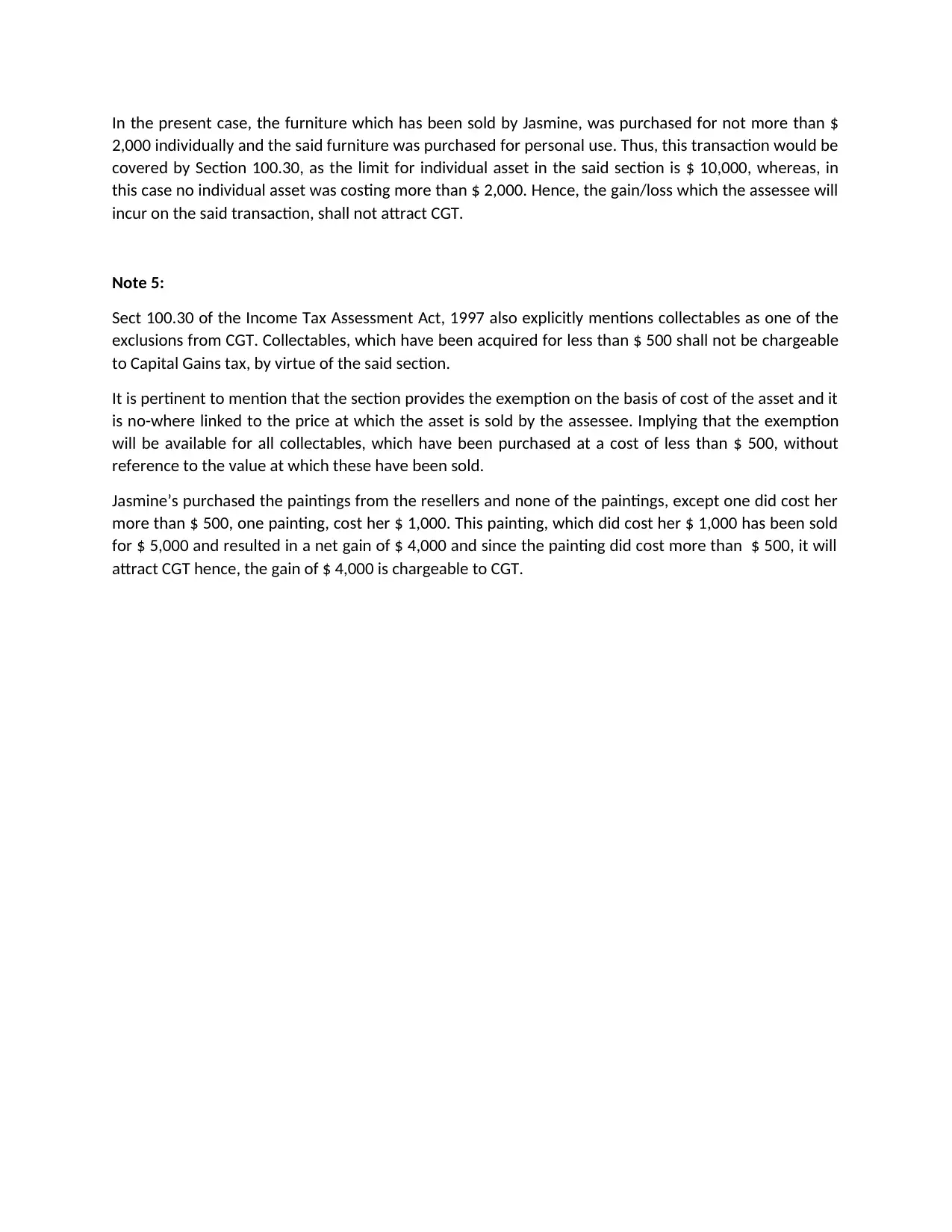
In the present case, the furniture which has been sold by Jasmine, was purchased for not more than $
2,000 individually and the said furniture was purchased for personal use. Thus, this transaction would be
covered by Section 100.30, as the limit for individual asset in the said section is $ 10,000, whereas, in
this case no individual asset was costing more than $ 2,000. Hence, the gain/loss which the assessee will
incur on the said transaction, shall not attract CGT.
Note 5:
Sect 100.30 of the Income Tax Assessment Act, 1997 also explicitly mentions collectables as one of the
exclusions from CGT. Collectables, which have been acquired for less than $ 500 shall not be chargeable
to Capital Gains tax, by virtue of the said section.
It is pertinent to mention that the section provides the exemption on the basis of cost of the asset and it
is no-where linked to the price at which the asset is sold by the assessee. Implying that the exemption
will be available for all collectables, which have been purchased at a cost of less than $ 500, without
reference to the value at which these have been sold.
Jasmine’s purchased the paintings from the resellers and none of the paintings, except one did cost her
more than $ 500, one painting, cost her $ 1,000. This painting, which did cost her $ 1,000 has been sold
for $ 5,000 and resulted in a net gain of $ 4,000 and since the painting did cost more than $ 500, it will
attract CGT hence, the gain of $ 4,000 is chargeable to CGT.
2,000 individually and the said furniture was purchased for personal use. Thus, this transaction would be
covered by Section 100.30, as the limit for individual asset in the said section is $ 10,000, whereas, in
this case no individual asset was costing more than $ 2,000. Hence, the gain/loss which the assessee will
incur on the said transaction, shall not attract CGT.
Note 5:
Sect 100.30 of the Income Tax Assessment Act, 1997 also explicitly mentions collectables as one of the
exclusions from CGT. Collectables, which have been acquired for less than $ 500 shall not be chargeable
to Capital Gains tax, by virtue of the said section.
It is pertinent to mention that the section provides the exemption on the basis of cost of the asset and it
is no-where linked to the price at which the asset is sold by the assessee. Implying that the exemption
will be available for all collectables, which have been purchased at a cost of less than $ 500, without
reference to the value at which these have been sold.
Jasmine’s purchased the paintings from the resellers and none of the paintings, except one did cost her
more than $ 500, one painting, cost her $ 1,000. This painting, which did cost her $ 1,000 has been sold
for $ 5,000 and resulted in a net gain of $ 4,000 and since the painting did cost more than $ 500, it will
attract CGT hence, the gain of $ 4,000 is chargeable to CGT.
⊘ This is a preview!⊘
Do you want full access?
Subscribe today to unlock all pages.

Trusted by 1+ million students worldwide
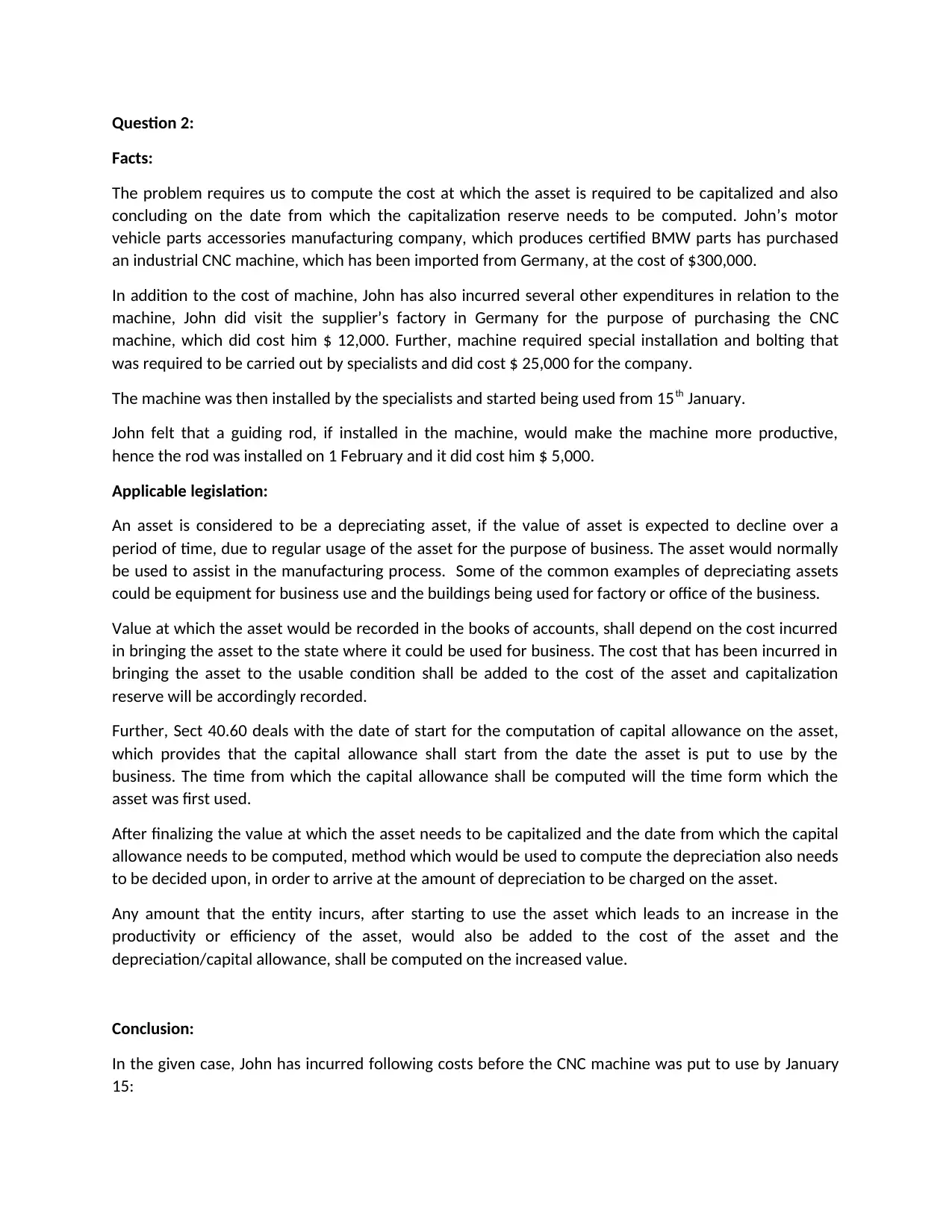
Question 2:
Facts:
The problem requires us to compute the cost at which the asset is required to be capitalized and also
concluding on the date from which the capitalization reserve needs to be computed. John’s motor
vehicle parts accessories manufacturing company, which produces certified BMW parts has purchased
an industrial CNC machine, which has been imported from Germany, at the cost of $300,000.
In addition to the cost of machine, John has also incurred several other expenditures in relation to the
machine, John did visit the supplier’s factory in Germany for the purpose of purchasing the CNC
machine, which did cost him $ 12,000. Further, machine required special installation and bolting that
was required to be carried out by specialists and did cost $ 25,000 for the company.
The machine was then installed by the specialists and started being used from 15th January.
John felt that a guiding rod, if installed in the machine, would make the machine more productive,
hence the rod was installed on 1 February and it did cost him $ 5,000.
Applicable legislation:
An asset is considered to be a depreciating asset, if the value of asset is expected to decline over a
period of time, due to regular usage of the asset for the purpose of business. The asset would normally
be used to assist in the manufacturing process. Some of the common examples of depreciating assets
could be equipment for business use and the buildings being used for factory or office of the business.
Value at which the asset would be recorded in the books of accounts, shall depend on the cost incurred
in bringing the asset to the state where it could be used for business. The cost that has been incurred in
bringing the asset to the usable condition shall be added to the cost of the asset and capitalization
reserve will be accordingly recorded.
Further, Sect 40.60 deals with the date of start for the computation of capital allowance on the asset,
which provides that the capital allowance shall start from the date the asset is put to use by the
business. The time from which the capital allowance shall be computed will the time form which the
asset was first used.
After finalizing the value at which the asset needs to be capitalized and the date from which the capital
allowance needs to be computed, method which would be used to compute the depreciation also needs
to be decided upon, in order to arrive at the amount of depreciation to be charged on the asset.
Any amount that the entity incurs, after starting to use the asset which leads to an increase in the
productivity or efficiency of the asset, would also be added to the cost of the asset and the
depreciation/capital allowance, shall be computed on the increased value.
Conclusion:
In the given case, John has incurred following costs before the CNC machine was put to use by January
15:
Facts:
The problem requires us to compute the cost at which the asset is required to be capitalized and also
concluding on the date from which the capitalization reserve needs to be computed. John’s motor
vehicle parts accessories manufacturing company, which produces certified BMW parts has purchased
an industrial CNC machine, which has been imported from Germany, at the cost of $300,000.
In addition to the cost of machine, John has also incurred several other expenditures in relation to the
machine, John did visit the supplier’s factory in Germany for the purpose of purchasing the CNC
machine, which did cost him $ 12,000. Further, machine required special installation and bolting that
was required to be carried out by specialists and did cost $ 25,000 for the company.
The machine was then installed by the specialists and started being used from 15th January.
John felt that a guiding rod, if installed in the machine, would make the machine more productive,
hence the rod was installed on 1 February and it did cost him $ 5,000.
Applicable legislation:
An asset is considered to be a depreciating asset, if the value of asset is expected to decline over a
period of time, due to regular usage of the asset for the purpose of business. The asset would normally
be used to assist in the manufacturing process. Some of the common examples of depreciating assets
could be equipment for business use and the buildings being used for factory or office of the business.
Value at which the asset would be recorded in the books of accounts, shall depend on the cost incurred
in bringing the asset to the state where it could be used for business. The cost that has been incurred in
bringing the asset to the usable condition shall be added to the cost of the asset and capitalization
reserve will be accordingly recorded.
Further, Sect 40.60 deals with the date of start for the computation of capital allowance on the asset,
which provides that the capital allowance shall start from the date the asset is put to use by the
business. The time from which the capital allowance shall be computed will the time form which the
asset was first used.
After finalizing the value at which the asset needs to be capitalized and the date from which the capital
allowance needs to be computed, method which would be used to compute the depreciation also needs
to be decided upon, in order to arrive at the amount of depreciation to be charged on the asset.
Any amount that the entity incurs, after starting to use the asset which leads to an increase in the
productivity or efficiency of the asset, would also be added to the cost of the asset and the
depreciation/capital allowance, shall be computed on the increased value.
Conclusion:
In the given case, John has incurred following costs before the CNC machine was put to use by January
15:
Paraphrase This Document
Need a fresh take? Get an instant paraphrase of this document with our AI Paraphraser
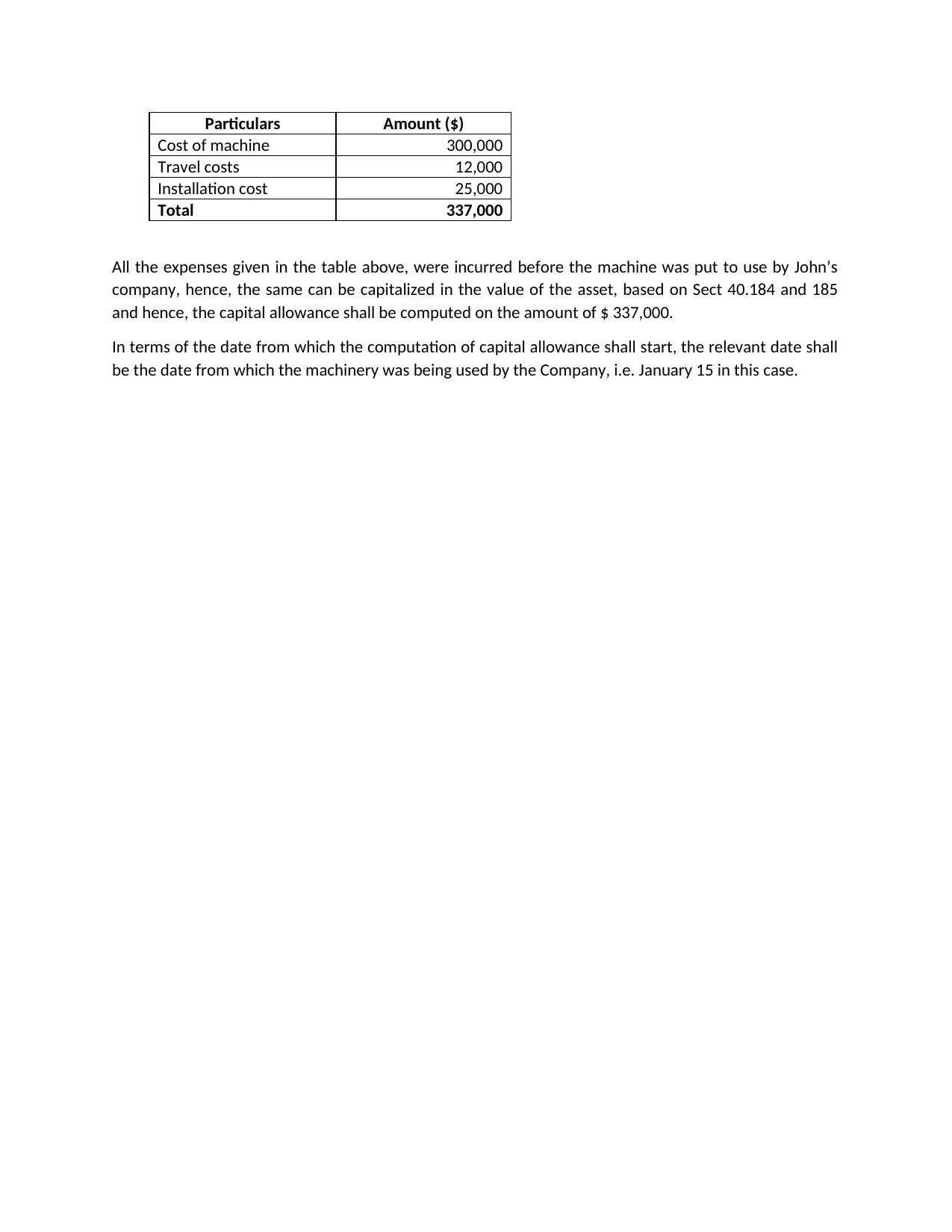
Particulars Amount ($)
Cost of machine 300,000
Travel costs 12,000
Installation cost 25,000
Total 337,000
All the expenses given in the table above, were incurred before the machine was put to use by John’s
company, hence, the same can be capitalized in the value of the asset, based on Sect 40.184 and 185
and hence, the capital allowance shall be computed on the amount of $ 337,000.
In terms of the date from which the computation of capital allowance shall start, the relevant date shall
be the date from which the machinery was being used by the Company, i.e. January 15 in this case.
Cost of machine 300,000
Travel costs 12,000
Installation cost 25,000
Total 337,000
All the expenses given in the table above, were incurred before the machine was put to use by John’s
company, hence, the same can be capitalized in the value of the asset, based on Sect 40.184 and 185
and hence, the capital allowance shall be computed on the amount of $ 337,000.
In terms of the date from which the computation of capital allowance shall start, the relevant date shall
be the date from which the machinery was being used by the Company, i.e. January 15 in this case.
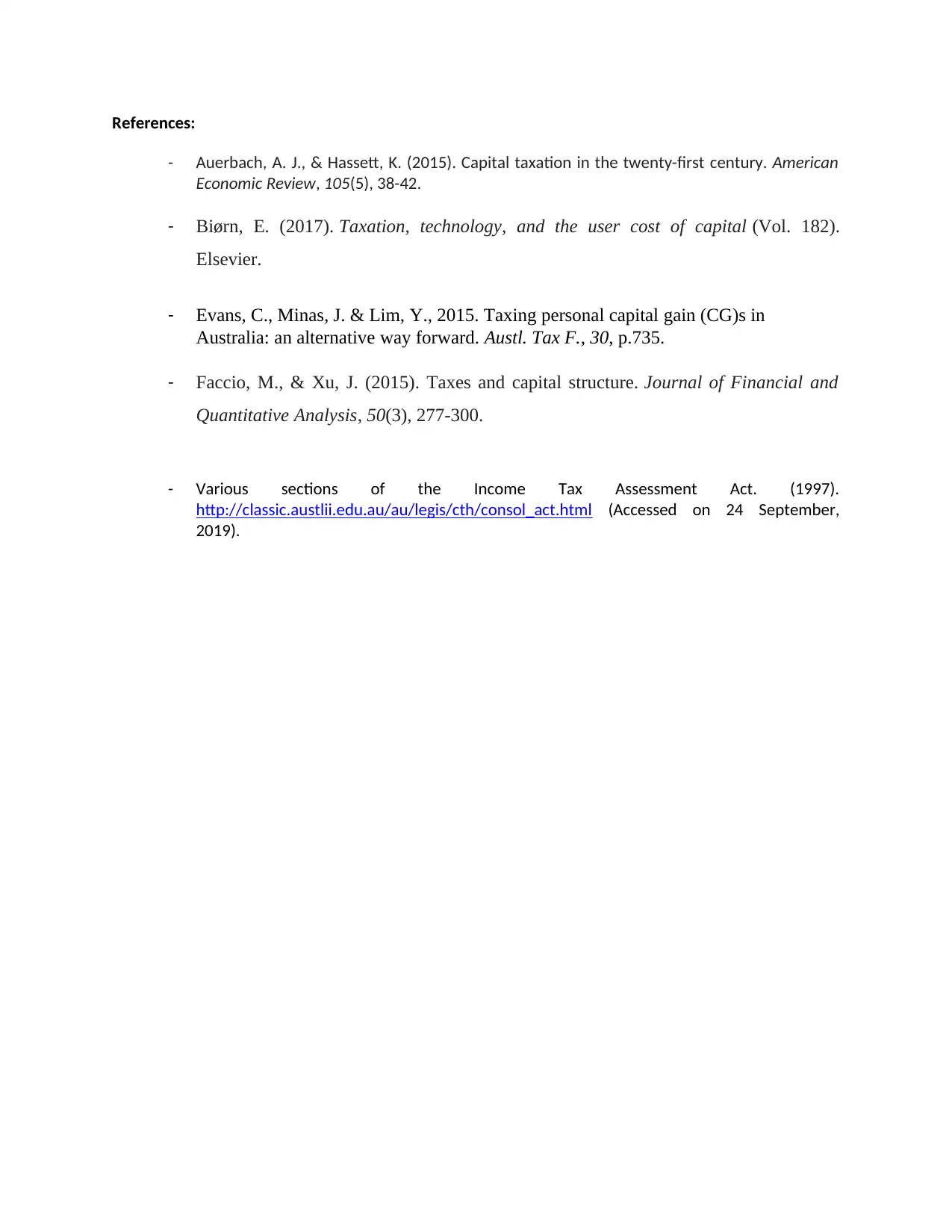
References:
- Auerbach, A. J., & Hassett, K. (2015). Capital taxation in the twenty-first century. American
Economic Review, 105(5), 38-42.
- Biørn, E. (2017). Taxation, technology, and the user cost of capital (Vol. 182).
Elsevier.
- Evans, C., Minas, J. & Lim, Y., 2015. Taxing personal capital gain (CG)s in
Australia: an alternative way forward. Austl. Tax F., 30, p.735.
- Faccio, M., & Xu, J. (2015). Taxes and capital structure. Journal of Financial and
Quantitative Analysis, 50(3), 277-300.
- Various sections of the Income Tax Assessment Act. (1997).
http://classic.austlii.edu.au/au/legis/cth/consol_act.html (Accessed on 24 September,
2019).
- Auerbach, A. J., & Hassett, K. (2015). Capital taxation in the twenty-first century. American
Economic Review, 105(5), 38-42.
- Biørn, E. (2017). Taxation, technology, and the user cost of capital (Vol. 182).
Elsevier.
- Evans, C., Minas, J. & Lim, Y., 2015. Taxing personal capital gain (CG)s in
Australia: an alternative way forward. Austl. Tax F., 30, p.735.
- Faccio, M., & Xu, J. (2015). Taxes and capital structure. Journal of Financial and
Quantitative Analysis, 50(3), 277-300.
- Various sections of the Income Tax Assessment Act. (1997).
http://classic.austlii.edu.au/au/legis/cth/consol_act.html (Accessed on 24 September,
2019).
⊘ This is a preview!⊘
Do you want full access?
Subscribe today to unlock all pages.

Trusted by 1+ million students worldwide
1 out of 6
Related Documents
Your All-in-One AI-Powered Toolkit for Academic Success.
+13062052269
info@desklib.com
Available 24*7 on WhatsApp / Email
![[object Object]](/_next/static/media/star-bottom.7253800d.svg)
Unlock your academic potential
Copyright © 2020–2025 A2Z Services. All Rights Reserved. Developed and managed by ZUCOL.




